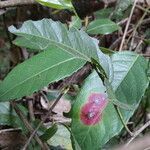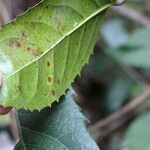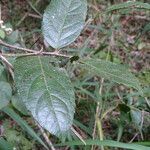Tree up to 15 m high. Branches glabrous. Leaf-blade elliptic, occasionally obovate, 10-15 cm long, 3-5.5 cm wide, apex acuminate, rarely acute, base narrowly cuneate to rounded, margins spinulose-serrate with incurved teeth, midrib prominent on both sides, lateral veins 6-9, more prominent below, curved, looping near margin, rigidly coriaceous, shiny, dark green above, paler below, glabrous; petiole 6-9 mm long, channelled, incurved. Flowers few; peduncles 1.2-2 cm long; pedicels 1-2 mm long. Sepals broadly ovate-triangular, 2-5 mm diam., concave, leathery, ciliolate along margin. Petals 3-5, unequal, broadly ovate-rotund, 3.5-8 mm long, 4-7 mm wide, concave, ciliolate along margin, 'deciduous'; petaloid scales elliptic-subrotund, 7 mm long, 4-5 mm wide, with somewhat fleshy tumid pubescent gland on inner face at base. Stamens: filaments 3-5 mm long; anthers narrowly ovate, slightly divaricate at base, 3.5 mm long. Ovary ellipsoid, 4-8 mm long, 4-5 mm wide, ridged; style almost none; stigmas 4-5, 1-1.5 mm long, spreading. Fruit yellow or green, 2.5-4 cm diam., with persistent style, 'tardily dehiscent into 4-5 longitudinal sections when dry' (Wild, 1.c.). Seeds few, subglobose, c. 1 cm diam.
A shrub or small tree. It grows 3-5 m high. It can grow 15 m tall. The bark is brown and smooth. The branches spread out and are inclined to droop. The leaves are alternate and simple. They are oblong. They are 7-16 cm long by 2-6 cm wide. The leaves are leathery and a glossy vivid green. They are paler and more dull underneath. The edges of the leaves have spiny teeth which point forward. The leaf stalk is 1.2 cm long. The flowers are creamy-white and 1.5-2 cm across. They occur either singly or as a few flowers together. They are 1-2 cm long. The fruit is a fleshy berry-like capsule. It is yellow to brown. It is 4 cm across. It dries out and splits open into 5 valves. There are several seeds.
Evergreen shrub or small tree, 0.45-15.00 m high. Leaves alternate, shortly petioled; blade usually elliptic, coriaceous, margins spinulose-serrate; stipules deciduous, scars present. Flowers bisexual or male, in axillary, spike-like racemes; sepals 4 or 5, free, unequal, imbricate, concave; petals similar to sepals but larger, petaloid scale opposite each petal; stamens many, in several rows, inner hypogynous, outer attached to base of scales; ovary superior, 1-locular, thick fleshy wall; style almost absent; stigmas 4 or 5. Flowering time Sept.-Apr. Fruit a globose berry.
Leaf-lamina 7–16 x 2.5–6 cm., oblanceolate-oblong to lanceolate-oblong, apex acuminate, base cuneate, margin spinulose-serrate, lateral nerves in c. 7 pairs, slightly raised on both sides, venation laxly reticulate; petioles up to 1.2 cm.; stipules 5–7 mm. long, very caducous, narrowly oblong, ciliate at the margins.
Petals whitish-green, similar to the sepals but c. twice the size, also unequal; petaloid scales c. 0.7 x 0.35 mm., oblong or elliptic-oblong, rounded at the apex, margin ± ciliolate with a fleshy, pubescent, elliptic or more usually bilobed gland at the base.
Flowers in short, axillary, spike-like racemes usually 0.5–2 cm. long; peduncles 2–3 mm. long; pedicels stout, c. 1 mm. long, bracteoles 1 mm. long, very caducous, ovate, acute, with ciliate margins.
Fruit yellow, c. 2.5 cm. in diam., globose, smooth, style persistent as a short point, slightly fleshy and berry-like at first, tardily dehiscent into 4–5 longitudinal sections when dry.
Stamens numerous; filaments white, 8 mm. long, glabrous; anthers oblong, anther-thecae c. 2 x 0.75 mm., slightly divaricate at the base.
Sepals 4–5, 1.5–3.5 mm. in diam., unequal, orbicular, imbricate, very concave, margin ciliolate otherwise glabrous.
Evergreen shrub or small tree up to c. 7 m. tall; vegetative parts quite glabrous except for the stipule margins.
Ovary pinkish, narrowly ovoid, glabrous; style very short; stigmas 3–5, 1 mm. long, spreading.
Seeds few, c. 1 cm. in diam., subglobose.




